Trees Birds Mammals Fish Amphibians Reptiles
Wild Algarve
Bookshop
Pseudocraterellus undulatus (Pers.) Rauschert - Sinuous Chanterelle
Phylum: Basidiomycota - Class: Agaricomycetes - Order: Cantharellales - Family: Cantharellaceae
Distribution - Taxonomic History- Etymology - Identification - Culinary Notes - Reference Sources
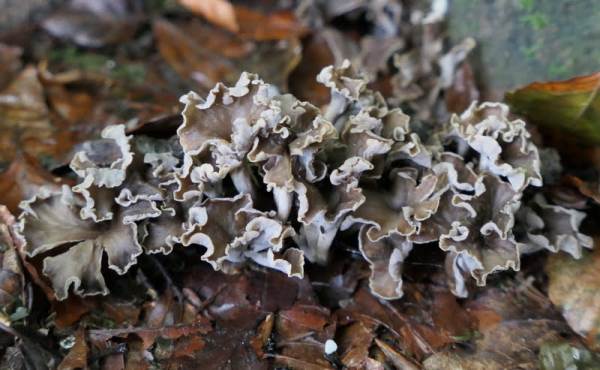
A very deep funnel characterises this sombre, edible fungus, which is commonly known as the Sinuous Chanterelle. The fruitbodies grow on soil under beeches and oaks, but their coloration makes them easy to miss.
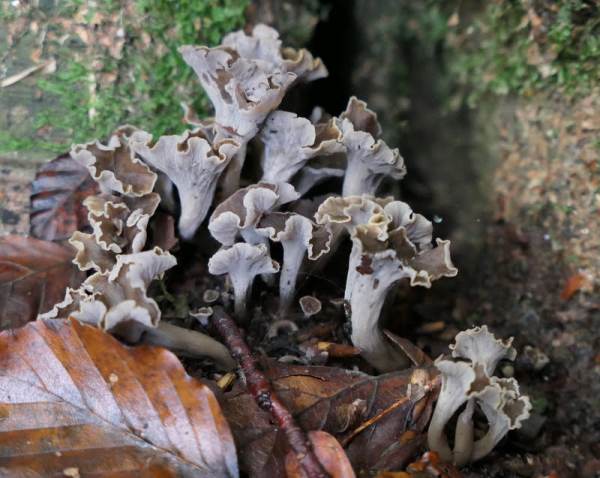
Distribution
Widespread by uncommon to rare in Britain and Ireland, the Sinuous Chanterelle is found also throughout mainland Europe.
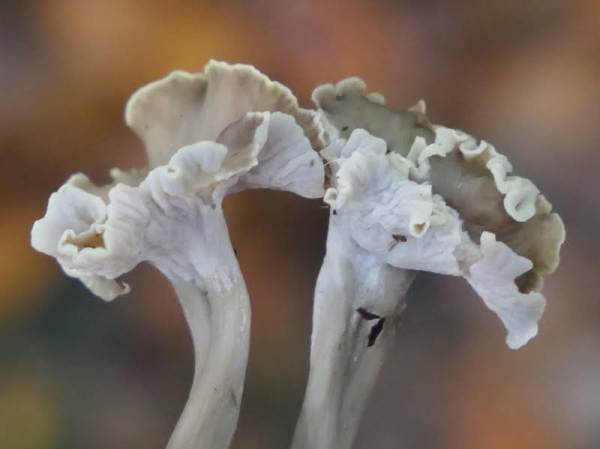
Taxonomic history
Christiaan Hendrik Persoon established the basionym of this species in 1801, when he gave it the name Merulius undulatus. It was moved to the genus Pseudocraterellus by English mycologist Edred John Henry Corner (1906 - 1996) in 1958, but its currently-accepted (NB not yet by all authorities!) scientific name dates from a 1987 (posthumous) publication by German botanist/mycologish Stephan Rauschert (1931 - 1986).
Synonyms of Pseudocraterellus undulatus include Merulius undulatus Pers., Pseudocraterellus sinuosus (Fr.) Corner, and Craterellus sinuosus (Fr.) Fr.
Etymology
The specific epithet undulatus refers to the undulating form of the cap margin.
Identification guide
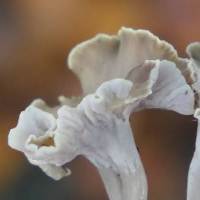 |
Cap
The deeply funneled fruitbody has a wavily-lobed margin; its diameter ranges from 1 to 2.5 cm, with a height of 1-2cm. The colour of the upper (infertile) surface varies from mid grey-brown to dark grey or black. There is no visible abrupt delineation between the fertile surface and the infertile part of the stem.
The deeply decurrent outer (fertile or hymenial) surface is pale grey to ochre grey, pruinose and either smooth or only finely longitudinally wrinkled. |
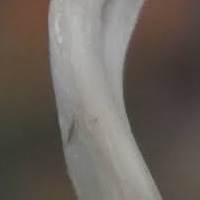 |
Stem
The grey pruinose stem tapers towards the base. Stems are often clustered and sometimes caespitose (joined at their bases). |
| |
Spores
Ellipsoidal, some slightly constricted; smooth, 8.8-11.5 x 5-7.5μm; hyaline.
Spore print
Yellowish ochre.
Other microscopic characters
The basidia are four spored. In contrast, the basidia of Craterellus cinereus (rather similar in appearance to the Sinuous Chanterelle but with a much more deeply wrinkled hymenial surface and a distinct stem) are distinguished by being five spored. |
Odour/taste |
Odour pleasantly fruity; taste mild but not
distinctive. |
Habitat & Ecological role |
In Britain this uncommon species is most often found in
deciduous forests under Beech trees; it also occurs with oaks. |
Season |
June to November in Britain and Ireland. |
Similar species |
Cantharellus cibarius is a bright yellow or yellow-orange fungus of similar form but more wrinkled hymenial surface; its fruitbodies are usually larger.
Cantharellus tubaeformis has a brownish cap and a yellow stem.
Craterellus cornucopioides is usually larger and has a scaly and more open-funneled fruitbody. |
Culinary Notes
Pseudocraterellus undulatus is too rare in Britain to be collected for culinary use..
Reference Sources
G. Kibby; Mushrooms and Toadstools of Britain and Europe, vol 1; (Second edition 2017); published by Geoffrey Kibby. ISBN 978-9998857-0-0.
British Mycological Society, English Names for Fungi
Dictionary of the Fungi; Paul M. Kirk, Paul F. Cannon, David W. Minter and J. A. Stalpers; CABI, 2008
Taxonomic history and synonym information on these pages is drawn from many sources but in particular from the British Mycological Society's GB Checklist of Fungi.
Acknowledgements
This page includes pictures kindly contributed by Iris Millar.
Top of page...
Fascinated by Fungi. Back by popular demand, Pat O'Reilly's best-selling 450-page hardback book is available now. The latest second edition was republished with a sparkling new cover design in September 2022 by Coch-y-Bonddu Books. Full details and copies are available from the publisher's online bookshop...